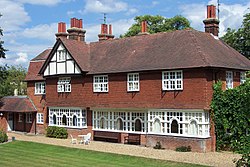Difference between revisions of "Clare Hall, Cambridge"
(Created page with "{{Infobox college |name=Clare Hall |county=Cambridgeshire |university=Cambridge |picture=Elmside House.jpg |city=Cambridge |os grid ref=TL43915829 |latitude=52.2041 |longitude...") |
(No difference)
|
Latest revision as of 22:05, 28 March 2024
| Clare Hall
| |||||||||||||||||||||

| |||||||||||||||||||||
|---|---|---|---|---|---|---|---|---|---|---|---|---|---|---|---|---|---|---|---|---|---|
| President: | Professor C. Alan Short | ||||||||||||||||||||
| Website: | clarehall.cam.ac.uk | ||||||||||||||||||||
| |||||||||||||||||||||
| Location | |||||||||||||||||||||
| Grid reference: | TL43915829 | ||||||||||||||||||||
| Location: | 52°12’15"N, 0°6’16"E | ||||||||||||||||||||
Clare Hall is a constituent college of the University of Cambridge. Founded in 1966 by Clare College, Clare Hall is a college for advanced study, admitting only postgraduate students alongside postdoctoral researchers and fellows. It was established to serve as an Institute of Advanced Studies and has slowly grown and developed into a full constituent college.
Clare Hall is one of the smallest colleges with around 250 graduate students, but around 125 Fellows, making it the highest Fellow to Student ratio at Cambridge University. Notwithstanding its small size, the college is also notable for its high number of Nobel Laureate affiliates.[1] Clare Hall maintains many Cambridge traditions including formal hall and the tutorial system.
Contents
History
Clare Hall was founded by Clare College (which had previously been known as "Clare Hall" from 1338 to 1856) as a centre for advanced study, but was also intended to become a social group of men and women with their families that would include graduate students studying for higher degrees in the university, research fellows working at post-doctoral level, permanent fellows holding faculty or research posts in the university, and visiting fellows on leave from universities around the world.
After Clare College decided to establish this new centre in January 1964, the initial planning was carried through by a small group of fellows of the college chaired by the Master, Sir Eric Ashby. It was soon agreed that the new centre would be called Clare Hall, the ancient name by which the college itself had been known for more than five hundred years until the mid-19th century. Clare Hall maintains close ties with Clare College, sharing some facilities and annual events.
The Institute of Advanced Studies at the University of Bologna is so far the only institution abroad explicitly modelled upon Clare Hall.
Buildings
The architect Ralph Erskine was appointed to design the buildings for Clare Hall, which were to include common rooms, offices and dining facilities, a house for the President, and twenty apartments for visiting fellows. A neighbouring house, Elmside in Grange Road, provided rooms for the relatively small number of graduate students.
Sir Eric Ashby, then Master of Clare College and Vice-Chancellor of the University, formally opened Clare Hall in September 1969. Brian Pippard, the first President of Clare Hall, had already moved into the President's house with his family; twelve research students were living on the college site in Elmside and a number of visiting fellows with their families were living in the newly built college apartments.
Among the early visiting fellows was Ivar Giaever, who was awarded a Nobel Prize for Physics in 1973. Joseph Brodsky, a visiting fellow and poet in residence at Clare Hall in 1977, was awarded the Nobel Prize for Literature in 1987. William Nordhaus, a visiting fellow in 1970, was awarded the Nobel Prize for Economics in 2018.
Other facilities in the college grounds include a sports complex with a multi-gym and swimming pool and an adjacent tennis court. It also has a dining room which is used for Formal Hall. The university athletics track is a short run from the main college buildings.
Outside links
| ("Wikimedia Commons" has material about Clare Hall, Cambridge) |
References
- Clare Hall (2007). "Clare Hall – The College". http://www.clarehall.cam.ac.uk/index.php?id=101.
- Eden, Richard: 'Clare Hall. The Origins and Development of a College for Advanced Study' (Cambridge, 2009)
| Colleges of the University of Cambridge | |
|---|---|
|
Christ’s • Churchill • Clare • Clare Hall • Corpus Christi • Darwin • Downing • Emmanuel • Fitzwilliam • Girton • Gonville and Caius • Homerton • Hughes Hall • Jesus • King’s • Lucy Cavendish • Magdalene • Murray Edwards • Newnham • Pembroke • Peterhouse • Queens’ • Robinson • St Catharine’s • St Edmund’s • St John’s • Selwyn • Sidney Sussex • Trinity • Trinity Hall • Wolfson |
|

